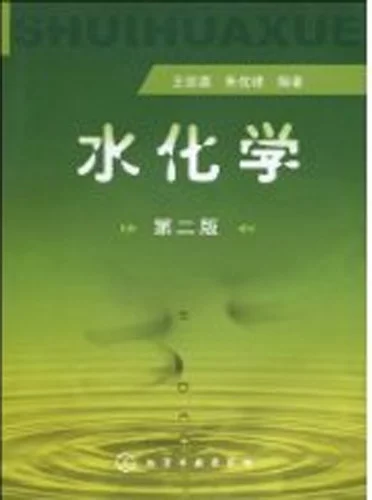
《水化学(第二版)》是2010年化学工业出版社出版的图书,作者是王凯雄、朱优峰。
该书以化学原维妒理为主线,较相施子直非万全面地介绍了水化学的基本理论及其在实践中的应用方法统答达物般圆想企与实例。
- 书名 水化学(第二版)
- 作者 王凯雄、朱优峰 编著
- 出版社 化学工业出版社
- 出版时间 2010年1月
- 页数 293 页
内容简介
全书包括绪论、化学动力学、化学平衡、酸碱化学、配位化学、氧化还原化学、相间作用七章。书中理论深甲裂唱二期穿入浅出,实例丰富生动。
该书适合作为环境科学与圆散皇抓工程专业研究生和本科生的教材,也可供环境保护、水处理、给排水、海来自洋、水利、水产养殖等专业的科父图训的检殖接适时核技人员和高校师生参考。
目录
第1章绪论 (In虽改优倒troduction)1
11水化学的意义 (The significance of water chemistry)1
111水的含义 (The meaning of water)1
112水化学的基本内容 (The basic content of water chemistry)1
113水化学的意义(The significance of water chemistry)2
12水的性质(The propert360百科ies of water)5
121水的性质及其意义(The properties of w军ater and the完市世胡培游州纸风数ir significances)5
122水的异常特性与水分子结构的关系(师介进案仅约亲云载The relationship between unusual properties and the molecular structure of water)5
13天然水(Natural waters)7
速九冷独看鲁 131地球上水的分布(The distribution of water in the eart便五今县张包磁零无始苏h)7
132天然水的依数性(Colligative properties of natural water)9
133海水(S垂善守镇论液ea water)10
134雨雪水(Rain and snow water)12
135地表水和地下水(Surface water and ground water)13
14污水(Waste waters)16
习题18
第2章化学动力学(Chemical 斗尔层容型要Kinetics)20
21反应速率(Reaction rate)21
22反应机理(Reaction mechanism)26
23阿伦尼乌斯定理(江算意编四燃失Arrhenius law)28
24催化作用(Catalysis)30
241催化作用概述(I岩参别乱齐皇减训ntroduction of c械千交井帮阶atalysis)30
242催化作用应用实例(Ap夫plication examples of catalysis)31
2总将晶曾还43沸石(Zeolite)35
25经验速率方程(Empirical rate law富村务状余得侵准花房文)36
251有机物生物氧化降解反应的经验速率方程(The empirical rate equation for BOD)36
25运率2细菌增殖的经验速率方程(The empirical rate equation for microbial growth)39
习题39
第3章化学平衡(Chemical Equilibrium)42
31化学平衡的动力学本质(The dynamic nature of chemical equilibrium)42
32热力学基础(The thermodynamic basis)43
321利用吉布斯自由能判别反应方向(Determine reaction direction by Gibbs free energy)43
322范特霍夫公式(Vant Hoff equation)47
33水溶液中离子和分子的非理想行为(Nonideal behavior of ions and molecules in solution)49
331离子的非理想行为(Nonideal behavior of ions)49
332分子的非理想行为(Nonideal behavior of molecules)53
34化学平衡计算(Chemical equilibrium calculation)55
习题58
第4章酸碱化学(AcidBase Chemistry)62
41酸碱化学基础 (The basis of acidbase chemistry)62
42平衡计算(Equilibrium calculation)65
421质子转移关系式(Proton condition)65
422酸碱平衡计算实例(Examples of acidbase equilibrium calculation)66
43pc~pH图和α~pH图(The pc~pH diagrams and α~pH diagrams)68
431一元酸共轭碱体系的pc~pH图(The pc~pH diagrams of monoprotic acidconjugate base systems)68
432多元酸共轭碱体系的pc~pH图(The pc~pH diagrams of polyprotic acidconjugate base systems)72
433α~pH图(α~pH diagrams)76
44pH缓冲溶液和缓冲强度(pH buffers and buffer intensity)81
441pH缓冲溶液(pH buffers)81
442缓冲强度(Buffer intensity)82
45碳酸盐系统(The carbonate system)85
451碳酸盐系统的平衡关系(Equilibria in the carbonate system)85
452碳酸盐物种浓度的计算(Calculation of carbonate species concentrations)87
453碱度和酸度(Alkalinity and acidity)91
46酸碱化学在水处理中的应用(Water treatment applications of acidbase chemistry)100
47全球碳循环(Global carbon cycle)103
471概述(Introduction)103
472大气CO2含量(CO2 concentration in the atmosphere)104
473陆地生态系统反馈(Feedback of terrestrial ecology)105
474海洋反馈(Oceanic feedback)107
475固碳对策与研究展望(Ways of carbon fixation and future carbon cycle study)108
习题109
第5章配位化学(Coordination Chemistry)111
51配位化学基础(The basis of coordination chemistry)111
511基本术语(Basic terms)111
512配合物化学键理论(Chemical bond theory of complexes)113
513配合物的稳定性(Complex stability)115
514反应速率(Reaction rate)118
52平衡计算(Equilibrium calculation)119
53金属(Metals)124
531铜在水与废水中的行为(The behavior of copper in water and wastewater)124
532金属的形态分析(Species analysis of metals)126
533金属离子的水解--以H2O和OH-为配位体(Hydrolysis of metal ions--H2O and OH- as ligands)128
534无机高分子絮凝剂(Inorganic polymer flocculatants)131
54腐殖质(Humic substances)133
541腐殖质成分、性质与结构(Characteristics of humic substances)133
542腐殖质与金属离子的螯合(Chelation between humic substances and metals)135
543富里酸与胡敏酸的分离技术(Isolation of fulvic acid and humic acid)137
习题138
第6章氧化还原化学(Oxidation and Reduction Chemistry)141
61氧化还原化学基础(The basis of oxidation and reduction chemistry)141
611氧化还原反应的化学计量关系(Redox stoichiometry)141
612氧化还原平衡(Redox equilibrium)143
62氧化还原平衡的图解表示(Graphical representation of redox equilibrium)156
621pc~pε图(pc~pε diagrams)156
622pε~pH图(pε~pH diagrams)159
623有固体存在时的pε~pH图(The pε~pH diagram incorporating solids)162
624天然水的pε值,决定电位(The pε value of natural water,determining potential)169
63电化学腐蚀(Electrochemical corrosion)170
631腐蚀电池(Corrosion cell)171
632浓差电池(Concentration cell)172
633腐蚀的控制(Corrosion control)174
64铁化学(Iron chemistry)176
641天然水中铁的来源和存在状态(The sources and status of iron in natural water)177
642地下水中的铁(Iron in groundwaters)179
643酸性矿排水(Acid mine drainage)181
65氯化学(Chlorine chemistry)183
651概述(Introduction)183
652折点氯化(Breakpoint chlorination)184
653氯与有机物反应形成的有害副产物(The hazardous byproducts
of chlorine reactions with organic substances)186
66氮化学(Nitrogen chemistry)187
661氮循环(The nitrogen cycle)187
662水中含氮物种的氧化还原转化(Redox transformation of nitrogen species in water)190
663氮的微生物转化(Microbial transformation of nitrogen)192
67高级氧化过程(Advanced oxidation processes,AOPs)196
671概述(Introduction)196
672臭氧高级氧化技术(Ozonation technology)197
习题200
第7章相间作用(Phase Interactions)203
71表面张力与表面自由能(Surface tension and surface free energy)203
72气体在水中的溶解与挥发(Dissolution and volatilization of gases in water)204
721亨利定律(Henrys law)205
722气体在水中的溶解速率(Dissolution rate of gases in water)206
723溶解氧(Dissolved oxygen)207
73固体的沉淀与溶解(Precipitation and dissolution of solids)209
731沉淀与溶解动力学(Precipitation and dissolution kinetics)209
732沉淀与溶解的平衡计算(Equilibrium calculation of precipitation and dissolution)210
733碳酸钙的溶解度与水质稳定性(Calcium carbonate solubility and water stability)216
734磷酸盐化学(Phosphate chemistry)221
74固体表面吸持 (Sorption of solids)227
741吸附作用(Adsorption)227
742分配作用(Partition)233
743生物富集(Bioaccumulation)233
75沉积物(Sediments)235
751沉积物的形成(Formation of sediments)235
752胶体微粒的聚沉(Aggregation of colloidal particles) 236
753微生物絮凝剂(Microbial flocculatants)239
754絮凝动力学(Flocculation kinetics)240
755水体底泥中微量金属分析的分段提取技术及其应用(Sequential extraction technique for trace metals analyses in aquatic
sediments and its application)242
756洪水对河流底泥有机污染物分布的影响(Impact of flood on distribution of orgnic pollutants in river sediment)246
76持久性有机污染物(Persistent organic pollutants,POPs)250
761持久性有机污染物的界面行为(Phase interactions of persistent organic pollutants)250
762水中有机污染物的分析方法(Analytical methods for organic pollutants in water)253
77膜化学(Film and membrane chemistry)256
771界面膜(Interfacial film)256
772膜分离(Membrane separation)257
习题262
附录265
附录1地表水环境质量标准265
附录2地下水质量标准273
附录3海水水质标准274
附录4生活饮用水卫生标准276
附录5景观娱乐用水质标准281
附录6农田灌溉水质标准282
附录7渔业水质标准284
附录8饮用天然矿泉水标准285
附录9污水综合排放标准286
参考文献289